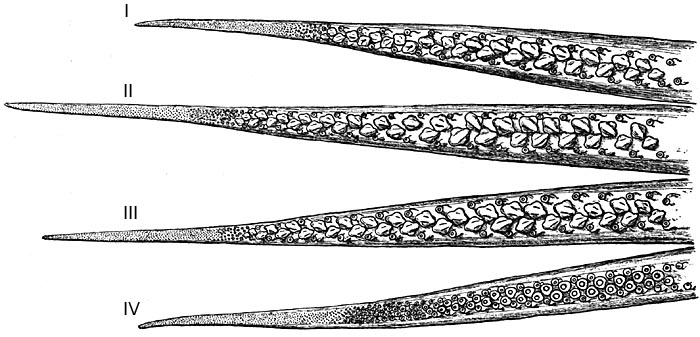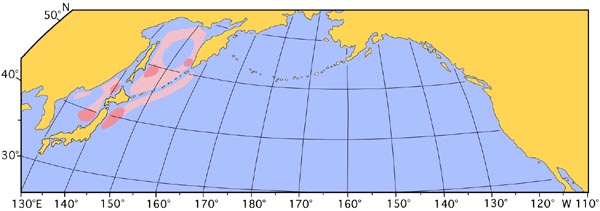Gonatopsis octopedatus
F. G. HochbergIntroduction
This is the type species of the genus Gonatopsis. It was briefly described by Sasaki (1920) based on a single immature specimen of unknown sex. A more detailed treatment of the same specimen was later provided by Sasaki (1929). A single mature male was described and illustrated by Okiyama (1970) and 4 spent females were treated by Nesis (1993).
Diagnosis
A Gonatopsis with ...
- 5 radular teeth per transverse row.
- long, slender arms; arm lengths slightly less than mantle length.
- arm tips attenuated; bearing up to 12 rows of tiny suckers.
Characteristics
- Arms
- Arms stout, long; equal to or slightly shorter than ML (longest 80-85% of ML).
- Arms subequal; arm formula typically: II>III>I=IV.
- Armature in 4 rows in proximal region of arms; arms I-III with 2 rows of medial hooks and 2 rows of small marginal suckers; arm IV with 4 rows of suckers.
- Distal third of arms attenuated, suckers tiny, uniform in size, borne on long stalks; in males arranged in 6-7 rows, in females arranged in 8-12 rows.
- Arm hooks first appear when animals are 30-60 mm ML.
- Arms I-III with 30-33 hooks; arms IV with 30 large medial suckers.
- Sucker rings on arms I-III with 5-7 irregular teeth; rings on arm IV with 9 well defined teeth.
- Tentacles
- Tentacles absent in adults; remnants present as rounded, indistinct tubercules between arms III and IV.
- Tentacles disappear when animals between 30-60 mm ML.
- Head
- Eyes large.
- Occipital crest poorly defined.
- Buccal membrane with 7 lappets.
- Beaks. Description of the beaks of G. octopedatus from Japanese waters can be found here. Description of the beaks of G. cf. octopedatus from the Gulf of California can be found here: Lower beaks; upper beaks.
- Radula with 5 teeth per transverse row; rachidian tricuspid, lateral 2 teeth unicuspid.
- Mantle
- Mantle tissue "soft"and watery.
- Mantle fusiform-shaped; tapered posteriorly; narrowed anteriorly.
- Skin pigmentation dark reddish brown.
- Maximum size of mature males 10-12 cm ML; of gravid and spent females. 16-39 cm ML; maximum weights to 2500 g.
- Fins and tail
- Tail absent.
- Fins short (ca. 25-30% of ML); slightly wider than long.
- Fins rounded, kidney-shaped.
- Photophores
- Photophores absent.
- Photophores absent.
- Viscera
- Ink color black.
- Mature ovarian eggs ovoid; maximum size, 4.3 x 2.5 mm.
- Spermatophore length, 10.7 mm.
- Measurements and counts (see sources listed)
Character/Catalog no. 332918 ?? Institution USNM NSMT Status Holotype -- Sex ukn male Maturity immature mature ML 65 99 MW 22 30 FL 19 ukn FW 30 ukn AL (right)
1 45 79 2 55 83 3 52 82 4 53 72 Arm formula
2>3>4>1 2=3>1>4 Hook counts
1 27 32 2 33 32 3 33 32 Sucker counts
4 30 ukn Teeth on sucker rings
ukn 5-7 Spermatophore L -- 10.7 Depth 804 810 Source Sasaki (1929) Okiyama (1970)
Comments
Information on characters listed above is taken from Sasaki (1929) and Okiyama (1970).
Hatchlings and paralarvae have not been described for this species.
Life History
The species is very abundant in the Okhotsk Sea. Mature males are about half the size of mature females. Mating is head to head and spermatophores are transferred to the buccal region of the female. Spawning habits are not known but females are presumed to spawn in deep water. All eggs are spawned in a short time. Spent females often float to the surface and die. The body of spent females is very gelatinous and typically the arm tips and armature are lost. Mature males remain in better condition. Paralarvae move up in the water column shortly after hatching at depth. Juveniles are caught in the upper epipelagic layer at night.
Distribution
Type locality: Okhotsk Sea, Sakhalin Island, near Cape Patience, 48 22'30"N, 145 43'30"; depth of capture 804 m.
References
Akimushkin, I.I. 1963. Cephalopods of the Seas of the USSR. [English translation 1965 by A. Mercado, IPST: Jerusalem].
Nesis, K.N. 1993. Spent females of deep-water squid Gonatopsis octopedatus Sasaki, 1920 (Gonatidae) in the epipelagic layer of the Okhotsk and Japan seas. Ruthenica, 3(2): 153-158.
Nesis, K.N. 1997. Gonatid squids in the subarctic north Pacific: ecology, biogeography, niche diversity and role in the ecosystem. Advances in Marine Biology, 32: 243-324.
Okutani, T. 2005. Cuttlefishes and Squids of the World. National Cooperative Association of Squid Processors: Tokyo. 254 pp.
Okutani, T., T. Kubodera and K. Jefferts. 1983. Diversity, distribution and ecology of gonatid squids in the subarctic Pacific: A review. Bull. Ocean Res. Inst., Univ. Tokyo, No. 26 (1):150-192.
Sasaki, M. 1920. Report on cephalopods collected during 1906 by the United States Bureau of Fisheries steamer "Albatross" in the northwestern Pacific. Proceedings of the United States National Museum, 57(2310): 163-203.
Sasaki, M. 1929. A Monograph of the Dibranchiate Cephalopods of the Japanese and Adjacent Waters. Journal of the College of Agriculture, Hokkaido Imperial University, 20 (Supplement): 1-357.
About This Page
F. G. Hochberg

Santa Barbara Museum of Natural History, Santa Barbara, California, USA
Correspondence regarding this page should be directed to F. G. Hochberg at
Page copyright © 2015 F. G. Hochberg
All Rights Reserved.
- First online 31 May 2006
- Content changed 11 October 2015
Citing this page:
Hochberg, F. G. 2015. Gonatopsis octopedatus . Version 11 October 2015. http://tolweb.org/Gonatopsis_octopedatus/26879/2015.10.11 in The Tree of Life Web Project, http://tolweb.org/












 Go to quick links
Go to quick search
Go to navigation for this section of the ToL site
Go to detailed links for the ToL site
Go to quick links
Go to quick search
Go to navigation for this section of the ToL site
Go to detailed links for the ToL site